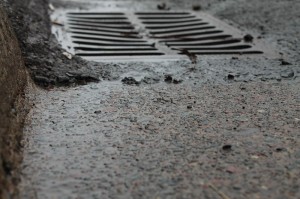
Rainwater can carry extra sand and salt into Duluth’s sewers, which filters, untreated into Lake Superior. Photo credit: Becky Mortensen
It’s a blustery day, common to springtime in Duluth, Minn. A bird flutters down to the bank and hops over to the edge of the stream. It bathes itself in the water. Not more than four feet away a neon yellow plastic cat litter bag is caught on a rock, breaking the natural beauty of the moment.
Pollution like garbage and shopping carts look bad on the surface, but the pollution that you can’t see is what has experts worried.
“We do a lot of education to inform folks that what they put on the street goes into the streams,” said Chris Kleist, stormwater utility project coordinator for the city of Duluth.
Kleist works to promote education about stormwater runoff. Every spring, people sweep their sidewalks clear of the residual winter sand and salt. Some of that sand and salt is swept into the street.
When it rains, the water carries that extra sand and salt to the sewer. What some people may not realize is that it ends up draining, untreated, into Duluth’s many urban streams, and eventually into Lake Superior.
Duluth has a municipal separate storm sewer system or an MS4 permit, which means that stormwater runoff, operates on a sewer system that is untreated. Water that is flushed or washed down the drain in homes and businesses goes to the Western Lake Superior Sanitary District for treatment.
The street also carries garbage like cigarette butts, leaking automotive fluids, and other harmful pollutants into streams, causing issues with water quality as well as trout habitats.
Duluth has 43 named urban streams, 16 of which are designated trout streams by the Minnesota Department of Natural Resources.
Cool, clear water high in oxygen content are characteristics of a stream that will support a healthy habitat for trout.
Stormwater runoff can cause cool temperatures to rapidly change. It can quickly muddy water by carrying sand and extra sediment from the street. It eventually settles, covering gravel where trout spawn.
“It’s a slice of wilderness that runs through the city,” said Carl Haensel, the northern Minnesota representative for Trout Unlimited, a non-profit organization concerned with protecting trout habitat.
To him, the ability to walk a few blocks and be able to fish for trout is a rare experience.
Chester Creek is one of Duluth’s many streams that can be affected by polluted runoff. Photo credit: Becky Mortensen
“I love that [Duluth] gives me an opportunity to connect with a resource. It lets me get out in the stream and see

Rainwater can carry extra sand and salt into Duluth’s sewers, which filters, untreated into Lake Superior. Photo credit: Becky Mortensen
everything around me,” Haensel said. “A river is never the same river two days in a row. I like that changing environment, it always provides something new to explore.”
Haensel has been working with the Duluth Stream Corps to plant trees around the city. Planting trees near streams helps to reforest and revitalize trout streams.
“You can’t have a trout stream without a good forest around the river,” Haensel said. “If you sort of focus on maintaining a watershed in a holistic state it benefits everything.”
Runoff also increases from developments in watershed areas. Surfaces such as streets, driveways, and parking lots don’t absorb water increasing the amount of rainwater runoff. In the past, Duluth has had issues with the rapid rise of urban streams, usually brought on by heavy rainfall.
In 2003, Duluth had nearly 10 million gallons of untreated sewage overflow from stormwater runoff, as reported in an article from the Duluth News Tribune. The Environmental Protection Agency eventually threatened the city with fines.
As a result Duluth built an overflow tank with a hefty price tag of $20 million. The tank recently prevented 2.5 million gallons of overflow sewage from entering Lake Superior.
Duluth also has regulations regarding development in watershed areas.
In the case of cold water streams, development of structures must be at least 150 feet away from the river bank according to Duluth’s legislative code. This helps to keep a buffer zone between development and nearby streams.
Development decreases the natural vegetation in the watershed of streams.
“Once you start taking away the natural vegetation, you change the way the river functions, the hydrology,” said Josh Blankenheim, fisheries specialist for the Minnesota DNR.
Blankenheim explained in a phone interview that natural vegetation is important to maintain a consistent water flow to the stream. The roots that extend into the soil absorb water and slow down the runoff process. It helps to stabilize the streams habitat and support a healthy trout population.
“I think the biggest thing is continuing education about the two different sewer systems,” Kleist said. “I think they are one of our greatest resources. There really aren’t many cities that have trout streams almost every mile.”
